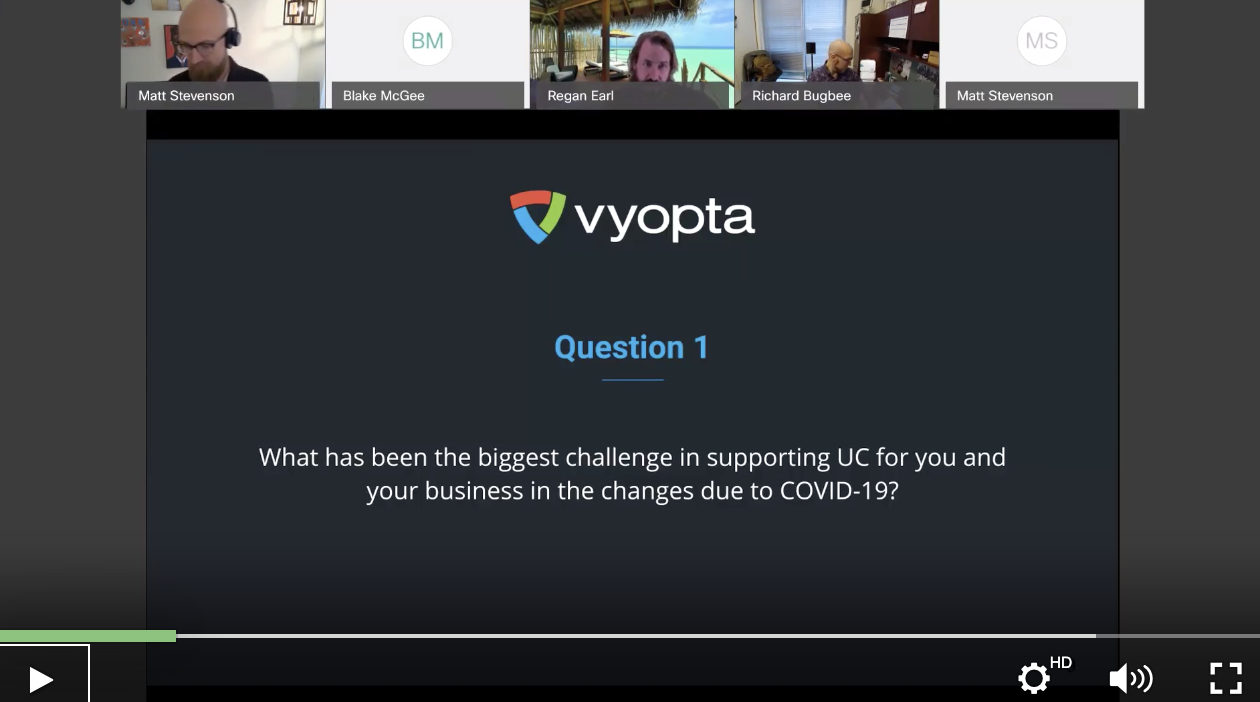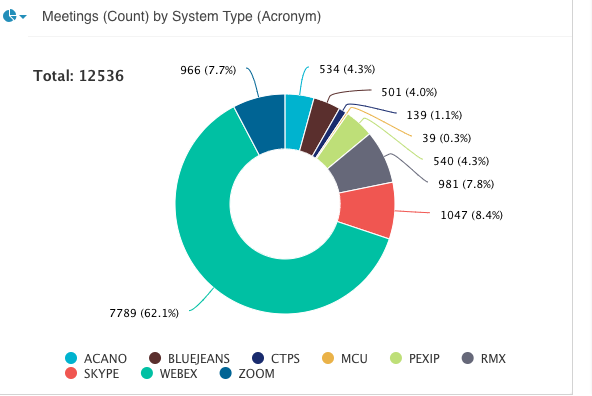On Thursday June 4th, Vyopta hosted a UC panel discussion on Optimizing Collaboration for the New Workplace: COVID-19 & Beyond! The panelists included UC experts Regan Earl, Sr. Unified Communications Engineer at Abbvie, Richard Bugbee, IT Manager for Voice and Video at Charter Communications, and Matt Stevenson, Sr. Solutions Engineer at Vyopta. The panel was focused on sharing their knowledge about collaboration technology – endpoints, infrastructure and architecture of video, voice and UC in the enterprise and predictions about what the new collaboration workplace will look like after COVID-19.
Matt Stevenson kicked-off the discussion by introducing the panelists, who are both Vyopta customers, and asking what their key initiatives currently are. Regan states that as a Biopharmaceutical company, Abbvie is currently working on video life cycle moving off pre-cisco hardware and creating their long-term strategy of moving to the cloud. Richard then states that Charter Communications has a different end-goal of using on-prem as an IP and host their own platforms.
Panel Questions
- What was the biggest challenge in supporting your UC environment?
- Richard with Charter Communications: I don’t think we understood how quickly requests would come in. One of the biggest challenges for us was on-boarding people that haven’t used the system, as quickly as possible, and with correct licensing. Beforehand we would have meetings to test our infrastructure. Another challenge was the education with all the new users and showing them things like how to use the microphone.
- Regan with Abbvie: Supporting a set number of users, and overnight turnaround. Managing your partners and their challenges that they were experiencing, going from x number of minutes, working to make sure platforms are stable and making sure our customers are good.
- What was the biggest surprise to you and your team in the shift of COVID-19?
- Regan with Abbvie: The biggest surprise for me was the work from home stigma = work from home less productive. At Abbvie, they were amazed at how fast they could go to optimizing network capabilities and see the teams come together. He found himself more productive without the traffic to and from work. Another surprise was that they were able to do the change overnight.
- Richard with Charter Communications: For Richard the biggest surprise was excitement of users. Majority was excited to have a new way to communicate with their teams. After the initial flood of getting up to speed, he learned that when you go remote, you stop hearing the normal day-to-day “hey this HMDI won’t work” so he found a lot more time to work on projects without getting interrupted.
- Matt: Did your support teams see an increase in requests and support tickets?
- Regan with Abbvie: For us it was more of an increase in collaboration peripherals where not everyone has a camera, not everyone has a microphone, so we set up a custom portal where they could order something and get it shipped.
- Richard with Charter Communications: We had some increase, but a lot of ours were part of the on-boarding. A lot of the initial spike was educating and training.
- Matt: Did you see an increase in support teams?
- Both: No.
- Matt: Did your support teams see an increase in requests and support tickets?
- What capabilities and tools are most important to support these changes?
- Regan with Abbvie: It was tough to troubleshoot a webcam. Shout out to Vyopta, we were able to look at quality of the call and be able to say ‘I know there is a problem’ and go from there. I also use a lot more instant messaging.
- Richard with Charter Communications: We’re a Cisco shop so Vyopta was helpful because I could log-in and compare what Vyopta was showing me vs. what control hub was showing me. Single number reach was the most important with the ability to call your phone and it rings other devices.
- POLL: What percent of your organization do you think will remain working from home?
- Average answer: 50% of workers will remain working from home
- Are you investigating or deploying to support a larger part of the workforce to permanently work from home?
- Richard with Charter Communications: We look at it as ‘How to plan ahead for cloud outage?’ We’re looking at things like MRA and looking at if we should start planning. We’re looking at on-prem and Cisco CMS. We want to make sure that users still have availability to place a call and that it’s going to work. How do we train and how do we support that? Easier to support work from home environment because they gets less complaints. When it’s your laptop you tend to complain less.
- Regan with Abbvie: A lot of the execs are video heavy. Big part of that is we do have MRA. Cloud registration was a lot better experience. Complex meeting rooms take more time to figure out what’s failing.
Read the rest of the panel questions and Q&A here in Part 2!
Want to watch this webinar recording?

Taylor Tachovsky is a passionate marketing coordinator with 4+ years of brand building experience directing campaigns and improving company results through social media content, strategic marketing campaigns, event planning, and outreach expertise. She has experience in many different branches of business including events, logistics, communications, and public relations. She holds a B.S in Management Communication from North Dakota State University and writes about topics related to technology and the event marketing industry.







